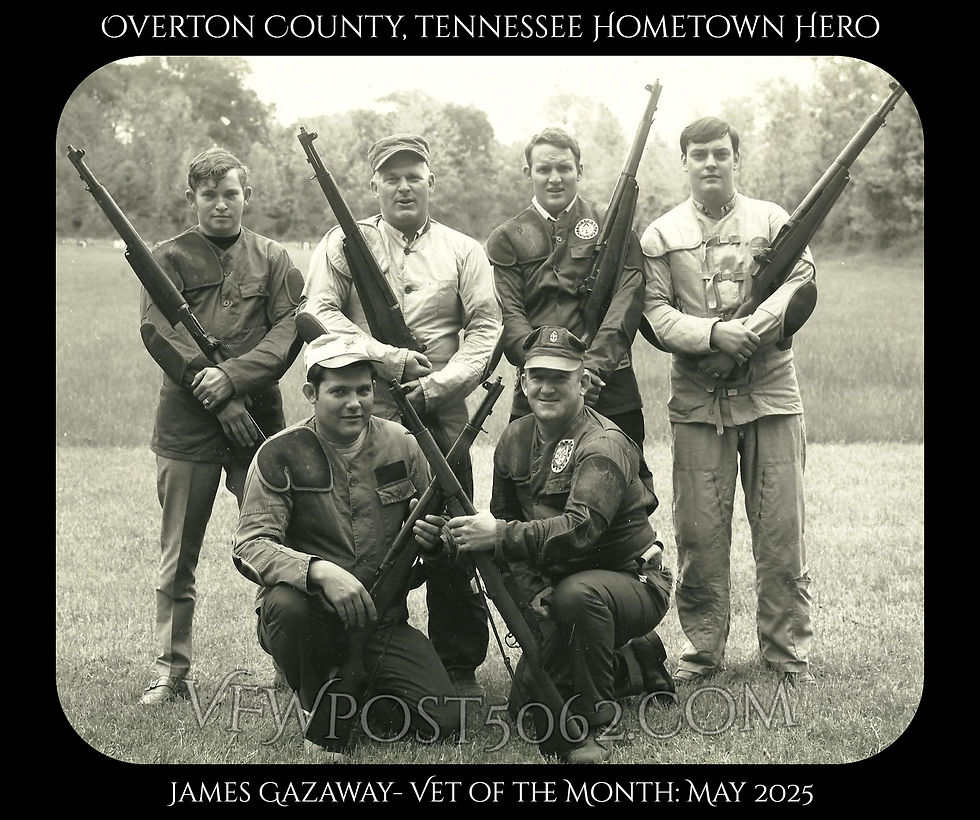History of James T. Davis
- VFW Post 5062: ADMIN

- Feb 5
- 3 min read
Updated: Apr 30
In 1958, James T. Davis - affectionately known to his friends as "Tom" - was diligently pursuing his studies at Tennessee Technological University (TTU) in Cookeville, a quaint town located approximately 20 miles from his cherished boyhood home in Livingston. Tom's childhood was reminiscent of a classic Norman Rockwell print, filled with the wholesome pursuits of youth. He excelled on the football field as a standout player for Livingston Academy, where his athletic prowess earned him respect and admiration from peers and coaches alike. Beyond sports, he embraced the great outdoors, spending countless hours hunting and fishing in the lush, deep woods that enveloped his hometown, creating memories that would last a lifetime.

However, in a pivotal moment of his young life, Tom made the significant decision to enlist in the United States Army before completing his senior year at TTU. This choice marked the beginning of a transformative journey that would take him far from the familiar comforts of home.
Upon enlisting, Tom was first sent to Fort Jackson, South Carolina, where he underwent rigorous basic training designed to prepare him for the challenges ahead. The training was intense and demanding, pushing him to his physical and mental limits. After completing basic training, he was assigned to Fort Devens in Massachusetts, where he received specialized instruction in the intricacies of "direction finding," a critical skill for military operations. This training would later prove invaluable as he prepared for his deployment to a conflict that was rapidly escalating in intensity.
In May 1961, after months of preparation, he received orders that would take him to the heart of the conflict: the 3rd Radio Research Unit in the Republic of Vietnam. Upon arrival, Davis quickly learned that the nature of his unit's work was fraught with peril. The 3rd Radio Research Unit was tasked with providing essential technical advice to South Vietnamese military units, focusing on the challenging task of locating enemy signals. Their expertise was crucial in helping these units develop strategies to pinpoint the locations of Viet Cong insurgents. However, the complex climate and rugged terrain of Indochina posed significant obstacles to their operations. The mountainous landscape, combined with the oppressive humidity, created a hostile environment that made conducting their work safely and securely a daunting challenge. To achieve success, Davis and his fellow soldiers often had to "get in close" to the enemy, which significantly increased their risk of encountering hostile forces.
On 22 December 1961, Davis received orders that would lead to a fateful mission. He was tasked with leading a Vietnamese team to an area approximately 12 miles from their base, with the objective of locating a Viet Cong guerilla force reported to be operating in the vicinity. The team traveled by truck to the designated area, where they planned to set up their equipment and coordinate efforts with another team in the field. Initially, the operation seemed routine, a standard mission in a challenging theater of war. However, as they traveled 10 miles outside the base, near a former French garrison at Cau Xang, the situation took a dire turn. The truck carrying Davis and his team hit a strategically-placed land mine, violently forcing them off the road and into a precarious situation. Almost immediately, the group came under heavy fire from enemy combatants, transforming their mission from hunters to the hunted in a matter of moments. Davis and his men displayed extraordinary bravery in the face of overwhelming odds, fighting valiantly to defend themselves against the relentless enemy assault.
Despite their courage and determination, they were ultimately overwhelmed by the superior firepower of the attacking forces. In a tragic twist of fate, a South Vietnamese Civil Guard unit, which was patrolling the area, quickly responded to the sound of gunfire, but their arrival was too late to save Davis and his team. The harrowing confrontation resulted in the deaths of Davis and nine other members of his unit, marking a somber moment in the escalating conflict.
Although Davis was not technically the first American to lose his life in combat in Vietnam, his sacrifice resonated deeply with the nation. In a speech made years later, President Lyndon Johnson referred to Specialist 4 James T. Davis as "...the first American..." to die in the war, a statement that has since been echoed across various platforms and websites. In any event, Davis was one of the earliest casualties of the Vietnam War, and his sacrifice did not go unnoticed. Just two weeks after his tragic death, in a poignant tribute to his service and the ultimate sacrifice he made for his country, the headquarters of his unit in Tan Son Nhut was renamed "Davis Station." This act of remembrance served as a lasting honor to a young man who had stepped forward to serve his nation, embodying the spirit of bravery and dedication that defined a generation of soldiers during one of the most tumultuous periods in American history.








Comments